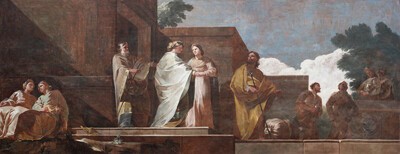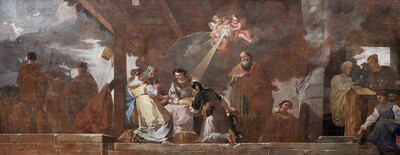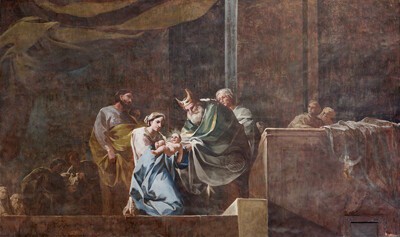- Cronología
- Ca. 1774
- Ubicación
- Church of the Monastery of Aula Dei, Zaragoza, Spain
- Dimensiones
- 306 x 790 cm
- Técnica y soporte
- Oil on plaster
- Reconocimiento de la autoría de Goya
- Documented work
- Titular
- Instituto Chemin Neuf
- Ficha: realización/revisión
- 07 Oct 2010 / 13 Jun 2023
Once again, the composition is centred on a large group of figures who are the main characters in the scene: in this case, Mary and Joseph are shown standing on a short staircase before a Hebrew priest, holding hands in the act of marriage. Mary is wearing a blue cloak and mauve tunic, while Joseph is dressed in a tunic of the same colour but with an ochre-coloured cloak. As the main figures in the scene, they are highlighted with more vivid colours and light, as is the woman who is depicted in a blue cloak and golden tunic who stands behind the Virgin, turning her face to talk to another woman in the middle ground.
The scene is completed by two women and two men who observe the events or talk amongst themselves, as well as two children on the left-hand side, one in the foreground with his back to us, who are playing on the staircase. The setting is an architectural space framed by some impressive red drapes gathered back at the top of the painting.
Further to the left we can see a semi-circular arch which opens the composition out onto a cloudy grey sky and a small group of sketched figures. On the right-hand side, Goya's original paintings were lost almost in their entirety: the group of men that complete the scene and the surrounding architecture of the ionic order that also allows us to see the sky in the background are the work of the Buffet brothers.
See Revelation to Saint Joachim and Saint Anne for a history of the complete set of works housed in this church.
Restauradas por Carlos Barboza y Teresa Grasa entre 1978 y 1979.
Restaurada por el Gobierno de Aragón entre 2009 y 2011: se hizo un estudio del estado de conservación, limpieza, consolidación, eliminación de sales, análisis y estudios ambientales, eliminación de elementos nocivos para la película pictórica, saneamiento y restauración de grietas, restauración de marcos y dotación de una iluminación apropiada.
-
Goya, su tiempo, su vida, sus obrasMadridTipografía de Manuel G. Hernández, Impresor de la Real Casa1887p. 462
-
Vie et ouvre de Francisco de GoyaParísOffice du livre1970pp. 39-41 (il.), cat. 42-48
-
BarcelonaPolígrafa1970vol. I, pp. 241-242
-
Las pinturas de Goya en la Cartuja de Nuestra Señora de Aula-DeiZaragozaMutua de Accidentes de Zaragoza1975
-
Sobre los documentos conservados en la cartuja de Aula DeiSeminario de Arte AragonésZaragoza1980pp. 119-122
-
Goya y Aragón. Familia, amistades y encargos artísticoscol. Col. Mariano de Pano y RuataZaragozaCaja de Ahorros de la Inmaculada de Aragón1995pp. 107-118 (il.)
-
Las pinturas murales de Goya en AragónMadridGobierno de Aragón y Electa España1996
-
Las pinturas murales de Goya en la cartuja de Aula DeiFundación Goya en Aragón y Turner2008vol. II, pp.123-137
-
Goya antes del viaje a Madrid (1746-1774)BarcelonaGalaxia Gutenberg/Círculo de Lectores y Fundación Amigos del Museo del Prado2010pp. 315-336






